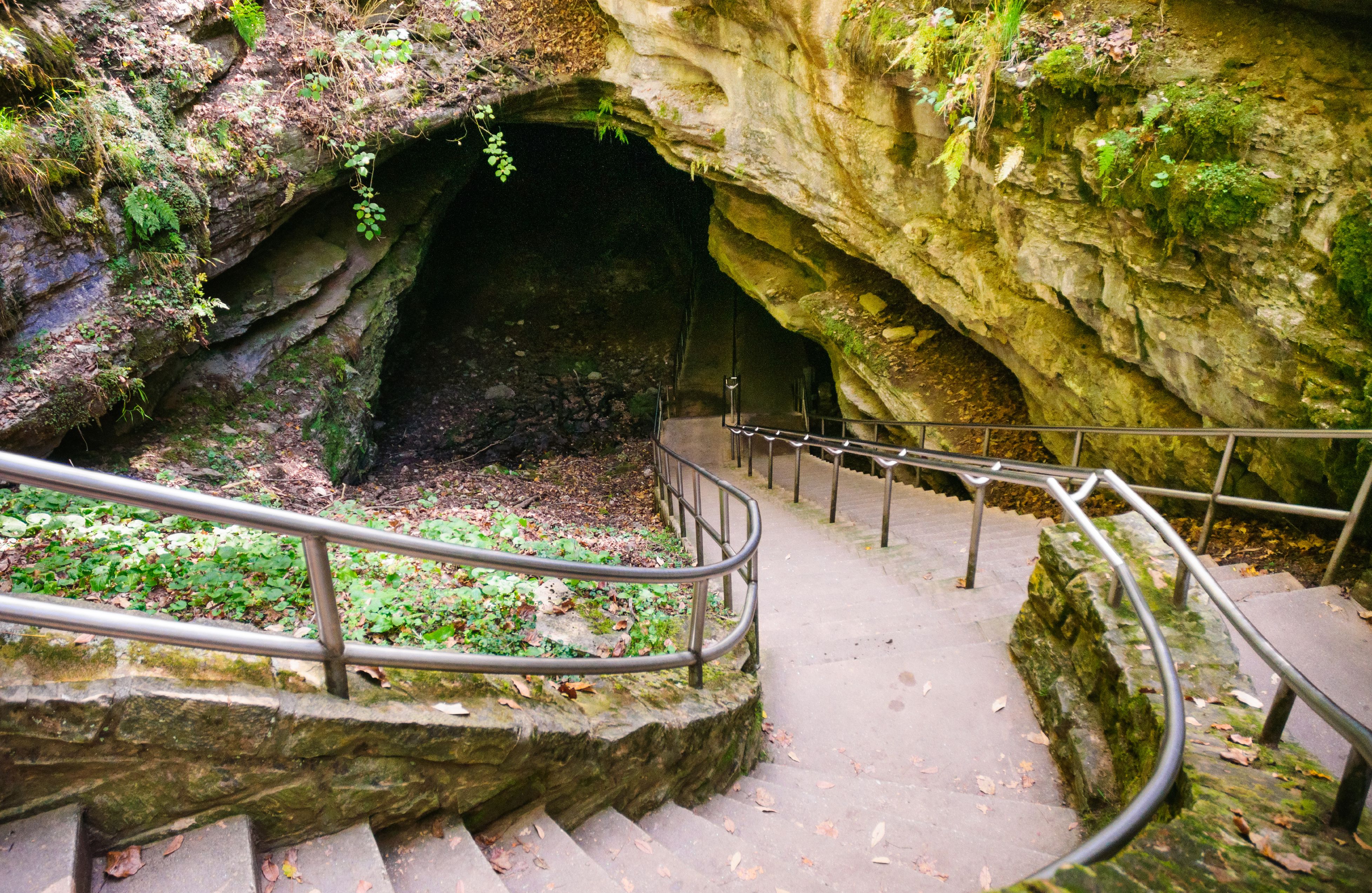
Kentucky's Best Kept Secrets: The Top Must-See Caves in the Bluegrass State

Kentucky is home to some of the most geologically significant caves in the United States. The state's caves are primarily formed in limestone, which is easily dissolved by water, leading to the creation of extensive cave systems. The Mammoth Cave System, for example, is the longest known cave system in the world, with over 400 miles of explored passageways. The geological processes that formed these caves took millions of years, and the resulting formations provide valuable insight into the earth's history. Stalactites, stalagmites, and other cave formations are created through the slow deposition of minerals carried by water, and they can provide clues about past climate conditions and the movement of underground water. Additionally, the presence of fossils in many Kentucky caves offers a glimpse into the ancient ecosystems that once existed in the region. Overall, Kentucky's caves are a treasure trove of geological information that can help scientists better understand the earth's past.
Kentucky's caves also play a crucial role in groundwater management. The limestone bedrock that forms the caves is highly porous, allowing water to easily flow through it. This means that Kentucky's caves are an important part of the region's aquifer system, which supplies drinking water to millions of people. Understanding how water moves through these cave systems is essential for managing and protecting this vital resource. Furthermore, the presence of caves can also impact surface water flow, as they can act as conduits for water to move from one area to another. By studying the hydrology of Kentucky's caves, scientists can gain a better understanding of how water moves through the landscape, which is essential for managing water resources and protecting against flooding.
Exploring the unique formations and features of Kentucky caves
Kentucky's caves are renowned for their unique formations and features, which make them a popular destination for cavers and tourists alike. One of the most iconic features of Kentucky caves is the presence of stalactites and stalagmites. These formations are created over thousands of years as mineral-rich water drips from the cave ceiling, leaving behind deposits that slowly build up into intricate structures. In some caves, these formations have grown to enormous sizes, creating otherworldly landscapes that are truly awe-inspiring to behold. Additionally, many Kentucky caves contain underground rivers and streams, which have carved out expansive passageways and chambers over time. These subterranean waterways add an extra element of adventure to cave exploration, as visitors may need to navigate through waist-deep water or even take a boat tour to fully experience the cave's wonders.
In addition to stalactites and underground rivers, Kentucky's caves also feature unique ecosystems that are adapted to the dark and often harsh conditions found underground. Many caves are home to rare and endemic species that have evolved to thrive in this environment. Some of these creatures, such as blind cavefish and cave crayfish, have adapted to life without light and have developed specialized sensory organs to navigate their surroundings. The presence of these unique species adds an extra layer of fascination to cave exploration, as visitors have the opportunity to witness life forms that exist nowhere else on earth. Overall, the unique formations and ecosystems found in Kentucky's caves make them a truly special and captivating natural wonder.
The history of cave exploration in Kentucky
The history of cave exploration in Kentucky is a rich and storied one that dates back thousands of years. Native American tribes such as the Shawnee and Cherokee were among the first people to explore Kentucky's caves, using them for shelter, religious ceremonies, and as sources of valuable resources such as flint for toolmaking. The extensive cave systems found in the region made them an important part of indigenous cultures, and many caves were considered sacred places with deep spiritual significance. European settlers later arrived in Kentucky and continued the tradition of cave exploration, often using caves as hideouts or bases during conflicts with Native American tribes or as shelter during harsh winters. As the population grew, caves became important sources of saltpeter, a key ingredient in gunpowder, leading to increased interest in their exploration and exploitation.
The 19th century saw a surge in interest in Kentucky's caves as scientific curiosity about their geological formations and ecosystems grew. In 1816, Mammoth Cave became one of the first tourist attractions in the United States, drawing visitors from around the country who were eager to witness its natural wonders. The cave's popularity continued to grow throughout the 19th century, leading to increased exploration and mapping efforts. In 1926, Mammoth Cave was designated as a national park, further solidifying its status as a premier destination for cave enthusiasts. Today, Kentucky's caves continue to be a source of fascination for explorers and scientists alike, with ongoing efforts to map and study their vast underground networks.
The ecological importance of Kentucky caves
Kentucky's caves are not only geologically significant but also play a crucial role in supporting unique and fragile ecosystems. The dark and often nutrient-poor conditions found in caves have led to the evolution of specialized species that are adapted to thrive in this environment. Many of these creatures are highly sensitive to changes in their surroundings and are considered indicator species for overall ecosystem health. For example, the endangered Kentucky cave shrimp is found only in a few select locations within the state's cave systems and is highly vulnerable to pollution and habitat destruction. Protecting these delicate ecosystems is essential for preserving the biodiversity found within Kentucky's caves.
In addition to supporting unique species, Kentucky's caves also play a vital role in maintaining groundwater quality. The porous limestone bedrock that forms the caves allows water to easily flow through it, acting as a natural filtration system that helps purify groundwater. This makes caves an important part of the region's aquifer system, which supplies drinking water to millions of people. Understanding how water moves through these cave systems is essential for managing and protecting this vital resource. Furthermore, many cave ecosystems are interconnected with surface ecosystems through underground rivers and streams, meaning that pollution or disturbances within caves can have far-reaching impacts on surrounding landscapes. Protecting Kentucky's caves is therefore not only important for preserving their unique ecosystems but also for safeguarding the overall health of the region's environment.
The role of Kentucky caves in local culture and folklore
Kentucky's caves have long held a special place in local culture and folklore, with many stories and legends passed down through generations about their mysterious depths. Native American tribes such as the Shawnee and Cherokee considered many caves to be sacred places with deep spiritual significance, often using them as locations for religious ceremonies or as sources of inspiration for myths and legends. European settlers later arrived in Kentucky and brought their own traditions and superstitions about caves with them, often viewing them as places of mystery and danger. Many caves were associated with stories of lost treasure or hidden passages that led to other worlds.
As tourism to Kentucky's caves grew throughout the 19th century, they became popular settings for adventure stories and novels that captured the public's imagination. Authors such as Mark Twain and H.P. Lovecraft wrote about the eerie beauty and hidden dangers found within cave systems, further cementing their place in popular culture. Today, Kentucky's caves continue to be a source of inspiration for artists, writers, and filmmakers who are drawn to their otherworldly landscapes and rich history. The enduring allure of Kentucky's caves in local culture and folklore serves as a testament to their enduring mystique and significance.
Conservation efforts and challenges facing Kentucky caves
Despite their ecological and cultural importance, Kentucky's caves face numerous conservation challenges that threaten their long-term health and viability. One of the most pressing issues is habitat destruction caused by human activities such as mining, logging, and urban development. These activities can lead to increased sedimentation within cave systems, which can smother delicate cave-dwelling species and disrupt underground ecosystems. Additionally, pollution from agricultural runoff or industrial activities can contaminate groundwater within caves, posing a threat to both cave-dwelling species and human drinking water supplies.
Another major challenge facing Kentucky's caves is the impact of tourism on their fragile ecosystems. Increased visitation can lead to physical damage to cave formations from accidental contact or vandalism, as well as disturbances to sensitive wildlife populations. Managing tourism in a way that minimizes these impacts while still allowing people to experience the wonder of Kentucky's caves is a delicate balancing act that requires careful planning and oversight.
Conservation efforts are underway to address these challenges and protect Kentucky's caves for future generations. Organizations such as the Kentucky Speleological Survey work to map and study cave systems while advocating for their protection. Additionally, state and federal agencies have implemented regulations aimed at preserving cave ecosystems while still allowing for responsible recreational use. By raising awareness about the importance of Kentucky's caves and implementing measures to mitigate threats, conservationists hope to ensure that these natural wonders will continue to inspire awe and wonder for years to come.
Visiting and experiencing Kentucky caves as a tourist or outdoor enthusiast
For those interested in experiencing the wonder of Kentucky's caves firsthand, there are numerous opportunities for exploration and adventure. Mammoth Cave National Park offers guided tours that cater to a range of interests and abilities, from easy walks through illuminated passages to more challenging spelunking expeditions that require crawling through narrow passageways. Visitors can marvel at the intricate formations found within Mammoth Cave while learning about its geological history from knowledgeable park rangers.
In addition to Mammoth Cave, there are numerous other commercial and privately-owned caves throughout Kentucky that offer guided tours and educational programs. Many of these caves feature unique formations such as underground waterfalls or rare crystal formations that are sure to captivate visitors' imaginations. For those seeking a more immersive experience, there are opportunities for caving expeditions led by experienced guides who can provide insight into the ecology and geology of Kentucky's underground landscapes.
For outdoor enthusiasts looking to combine cave exploration with other activities such as hiking or camping, Kentucky offers numerous opportunities for adventure. Many state parks feature hiking trails that lead to scenic overlooks or natural bridges that provide stunning views of the surrounding landscape. Additionally, several campgrounds are located near cave systems, allowing visitors to spend multiple days exploring both aboveground and underground wonders.
Overall, visiting Kentucky's caves offers a chance to connect with nature in a truly unique way while gaining a deeper appreciation for the region's geological history and ecological significance. Whether exploring on foot or by boat, visitors are sure to be awed by the beauty and mystery found within Kentucky's subterranean landscapes.







